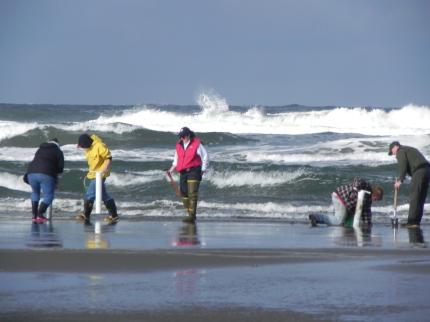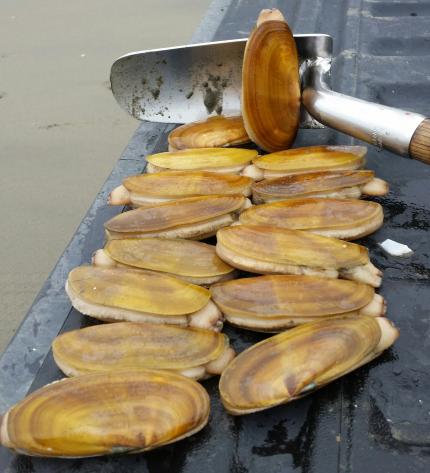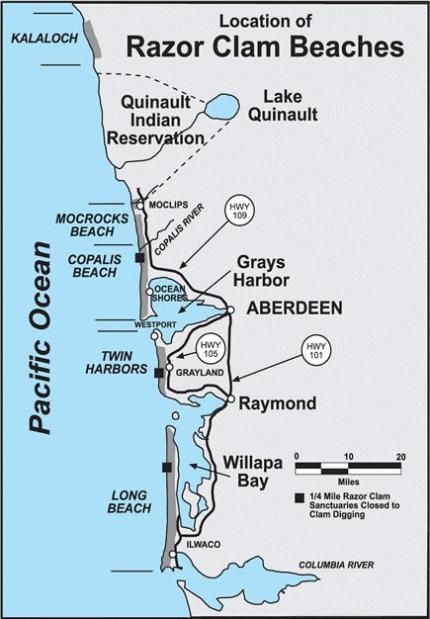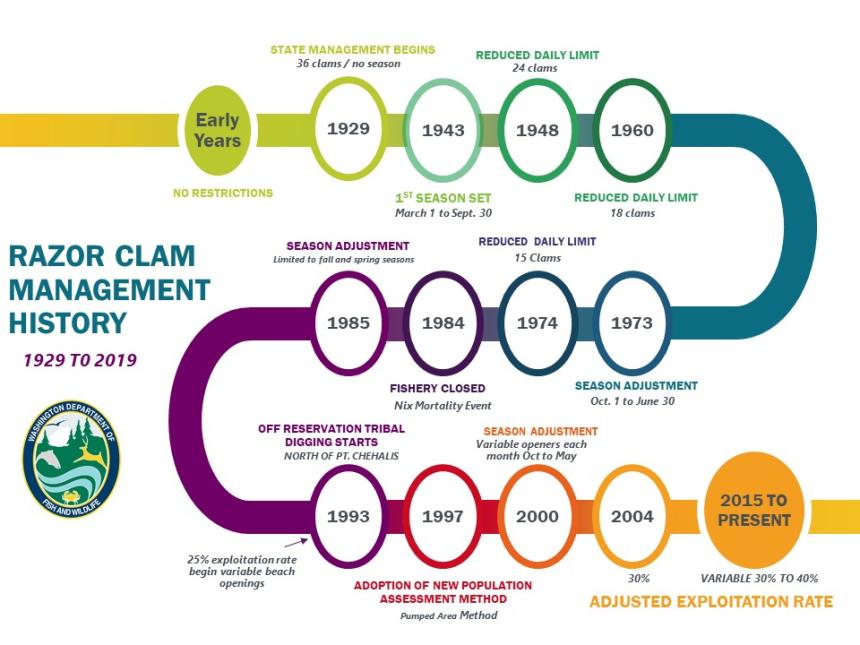
May 3, 2024
Contact: Bryce Blumenthal, 360-249-4628, ext. 232
Media contact: Mark Yuasa, 360-902-2262
WDFW approves final coastal razor clam digs of the spring season beginning May 6
OLYMPIA – Dig this! The final seven days of coastal razor clam digs of the season will proceed as planned from May 6-12, Washington Department of Fish and Wildlife (WDFW) coastal shellfish managers confirmed today.
“We are excited to send off a nice long season of uninterrupted digging with a closing tide series that contains the lowest tides of the year” said Bryce Blumenthal, a WDFW coastal shellfish biologist. “Between Sept. 29, 2023, through May 12, we offered a total of 250 digs on the four beaches across 100 days.”
Not all coastal beaches are open for every dig, so diggers are encouraged to make sure their intended destination is open before heading out. Optimal digging occurs between one and two hours before the listed time of low tide.
Shellfish and seafood enthusiasts can also start making plans to attend the Long Beach Razor Clam Festival on May 10-11. This long-running event celebrates the unique contribution of razor clams to Washington’s culture and coastal communities.
The following digs will proceed as scheduled, after marine toxin results from the Washington State Department of Health (DOH) showed razor clams are safe to eat.
Confirmed dates during morning (midnight to noon) low tides:
- May 6, Monday, 5:41 a.m.; -0.7 feet; Mocrocks
- May 7, Tuesday, 6:28 a.m.; -1.5 feet; Long Beach, Mocrocks
- May 8, Wednesday, 7:13 a.m.; -2.0 feet; Long Beach, Copalis
- May 9, Thursday, 7:57 a.m.; -2.1 feet; Long Beach, Twin Harbors, Copalis
- May 10, Friday, 8:41 a.m.; -1.9 feet; Long Beach, Twin Harbors, Mocrocks (Long Beach Razor Clam Festival)
- May 11, Saturday, 9:27 a.m.; -1.4 feet; Long Beach, Twin Harbors, Mocrocks (Long Beach Razor Clam Festival)
- May 12, Sunday, 10:16 a.m.; -0.8 feet; Long Beach, Twin Harbors, Copalis
As in past years, WDFW is asking beachgoers to avoid disturbing nesting snowy plovers – a small bird with gray wings and a white breast – by staying out of the dunes and posted areas along the southwest coast. Snowy plover nests are nearly invisible, and it is vital to give birds the space to live and thrive during nesting period, especially along the southern end on Twin Harbors – known as Midway Beach – the north end of Long Beach and the area north of Ocean City on Copalis Beach.
Avoid leaving leftover food or trash – which attracts predators – on the beach and picnic areas, keep pets on a leash, stay out of dunes, and avoid areas which are clearly marked with posted signs. When driving on the beach, please respect the 25 MPH speed limit and enter only at designated access points. Stay on the hard-packed sand near the high tide line to avoid crushing clam beds and snowy plover nests.
Several sections of coastal beaches are closed to driving now through Labor Day, except on days and hours when the recreational razor clam digging is open. These areas are clearly marked with signs.
On all open beaches, the daily limit is 15 clams per person. Each digger’s clams must be kept in a separate container, and all diggers must keep the first 15 clams they dig, regardless of size or condition, to prevent waste.
To dig razor clams, Washingtonians must have a valid 2024-2025 recreational hunting and fishing licenses. Licenses can be purchased from WDFW’s licensing website, and from hundreds of license vendors around the state. All diggers age 15 or older must have an applicable fishing license to harvest razor clams on any beach.
WDFW plans to announce tentative digging opportunities in early fall for the 2024-2025 season on this website. This summer, WDFW will conduct population assessments and regularly monitor domoic acid levels, a natural marine toxin produced by certain types of marine algae, that can be harmful or fatal if consumed in sufficient quantities. More information about domoic acid, as well as current levels at ocean beaches, can be found on WDFW's domoic acid webpage and on the DOH webpage.
The Washington Department of Fish and Wildlife works to preserve, protect, and perpetuate fish, wildlife and ecosystems while providing sustainable fish and wildlife recreational and commercial opportunities.
About Razor Clams

The Pacific razor clam is one of the most sought after shellfish in the state of Washington. Better roads and more leisure time have brought increasing numbers of diggers to the ocean beaches. It is not unusual to have as many as a thousand people per mile during a nice spring weekend day.
Recreational digging for razor clams can be enjoyed by children and senior citizens alike. All you need is a clam shovel or specialized tube, a container to put your clams in and, most importantly, your clam license. Be sure to check the regulations and current razor clam season information for the latest clam-digging requirements and other sport fishing regulation updates. During the fall and winter when low tides occur at night, thousands of clam diggers brave the elements to dig by lantern or flash light. Because there is a great deal of interest in digging at all times of the year, seasons are set to allow digging during daylight spring tides when there is better weather and during the fall/winter when diggers have to deal with the elements, but not as many clam diggers.
During certain times of the year, marine toxins, produced by some species of diatoms (algae) are taken in by razor clams and concentrated. When ingested, these toxins can cause illness and in very high concentrations can be fatal to humans. WDFW, in cooperation with the Washington Department of Health (DOH), samples clams on a routine basis to determine up-to-date toxin levels. If high toxin levels are detected, clam seasons are delayed or closed. WDFW and DOH work very hard to provide a safe and fun resource to enjoy.
Razor clam beaches
Digging on closed beaches could result in a fine. Please check map and current razor clam schedule, and observe signs -- particularly while digging on Copalis and Mocrocks beaches -- in order to determine that you are on the right beach digging legally.

Razor clams are found primarily on the intertidal coastal beaches (those that are exposed at low tide) from a +3 foot level to a -2 foot tide level. The Washington Department of Fish and Wildlife (WDFW) divides the harvest areas into five major management zones (see map):
- Long Beach from the Columbia River north to the mouth of the Willapa Bay (See map)
- Twin Harbors from Willapa Bay north to the south jetty at the mouth of Grays Harbor (See map)
- Copalis Beach from the north jetty at the mouth of Grays Harbor to the Copalis River (See map)
- Mocrocks from the Copalis River to the south boundary of the Quinault Indian Reservation and (See map)
- Kalaloch from the South Beach campground north to ONP Beach Trail 3. Learn more about Kalaloch beach at the National Park Service website.
Other areas where razor clams exist are: a series of sand spits in the mouth of Willapa Bay, the Quinault Indian Reservation and numerous small beaches north of Olympic National Park (ONP) Trail 3 at Kalaloch. The sand spits in Willapa Bay are referred to as the Willapa Spits and are used for commercial harvest.
Be sure to check the latest domoic acid levels at these beaches before heading out.
Razor Clam Season Setting and Management
Razor Clam Management
See the updated 2023-24 Razor Clam Management Plan for details on the proposed 2023-24 seasons. Comments on the plan may be sent to: razorclams@dfw.wa.gov
How Razor Clam Seasons are Set
Washington State has actively managed the coastal recreational razor clam fishery since 1929. Over the decades there have been many changes as more and more people continue to move to the state and discover how enjoyable participation in the fishery is. The flow chart below details the many changes fishery managers have made to address increased digging pressure.

Today, the season setting process starts with a very detailed summer population assessment of each beach. A good description of how WDFW conducts this work can be found in the WDFW video, "Razor Clams in Washington Stock Assessment." After this population assessment is completed, the data collected is used to make estimates of total number of clams under 3 inches (pre-recruits) and total number of clams over 3 inches (recruits). These estimates are made for each of five management beaches.
For each management beach, a Total Allowable Catch (TAC) is then calculated using a harvest rate that is applied to the estimate of recruit sized clams. The harvest rate used ranges between 30% and 40% depending on the overall strength of the population. The stronger the population, the higher the variable harvest rate and the weaker the population the lower the variable harvest rate. (The only exception is on the Kalaloch management beach where the TAC is fixed at 25.4%.)
On the three management beaches north of the mouth of Grays Harbor (Copalis, Mocrocks and Kalaloch) WDFW co-manages the razor clam resource with coastal tribes that have fishing rights in their usual and accustomed area (U&A). These include the Quinault Indian Nation which has fishing rights in the area that includes Copalis, Mocrocks and Kalaloch management beaches and the Hoh Tribe and the Quileute Tribe with fishing rights in the area that includes Kalaloch.
After the population assessment on these co-managed beaches is completed (by biologists and technicians from the state and the tribes working together), the TAC is calculated (in the same manner as we described above) with 50% then provided for the state fishery and 50% provided for tribal fisheries.
After the TAC’s have been finalized, WDFW begins to set state recreational razor clam openers in such a way to avoid exceeding the TAC or the state’s share of the TAC. In general, WDFW tries to provide openers each month (between October and May), while reserving clams for the months ahead. Obviously weather and surf conditions can cause great variations in the number of clams harvested on any specific day. However, should bad weather result in fewer clams being harvested, those clams remain a part of the TAC that will be used to set future openers.
When selecting days for harvest, WDFW always first considers the best low tides that fall around weekends. This is the time when the majority of harvesters can participate. When possible, week days with good low tides are also scheduled. Along the Washington coast, the best low tides (when digging success is optimized) always occurs during afternoon/evening (PM) hours in the fall and winter (between October and mid-March) and during morning (AM) tides in the spring (after mid-March.)
Only after the WDFW Director has approved the harvest dates and the Washington Department of Health Department analysis for marine toxins (from recent razor clam samples provided by WDFW) show clams are safe to each, then does WDFW announce that the upcoming harvest dates can proceed. That’s why it is important for harvesters to check this page before heading out to harvest razor clams.
In the end, the evidence is clear - a conservative management strategy allows razor clam populations to remain strong, allowing WDFW the flexibility to provide more harvest opportunities and more economic benefit to coastal economies.